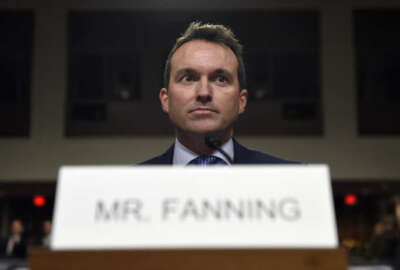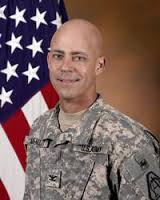 Exclusive
Exclusive Exclusive
How Army’s archaic evaluation system is hurting the service
As some of the best officers leave the Army, the service's personnel evaluation system is stuck in the 1950s and it's still years before anything can change.
Read part one of Federal News Radio’s special report, The Army is Shortchanging its Future Force,
There is an old saying that generals prepare for the last war they fought.
For the past decade and a half, the U.S. has been fighting a war in the Middle East against a lesser adversary, an enemy that in no way parallels the United States’ military might.
As cyber becomes more prominent and Russia flexes its muscles in Europe, Defense Secretary Ash Carter and senior military leaders realize the enemy is changing, which is why they are signaling for a shift in the talent makeup in the military.
The Army’s guidance given to promotion boards in 2016 reflected Carter’s call for a different kind of soldier; one that is creative and has advanced civilian degrees and broad experiences.
In that case, it would seem that Capt. Jim Perkins, executive director of the Defense Entrepreneurs Forum, an innovation engine of emerging defense leaders, would be a shoe-in for promotion. Perkins, also earned his M.B.A. from Georgetown University while in the Army.
Special Report Overview
Not only is he a high achiever, but he’s willing to pass up a much higher salary in the private sector in order to serve the public good.
As part of Federal News Radio’s special report The Army is Shortchanging its Future Force, Perkins said his experience is one example of how the Army is forcing out talented, promising and innovative officers from its ranks.
There are systemic and cultural issues keeping Perkins and his peers from being promoted.
In part one of this story, we discussed how the promotion boards worked and what purpose they serve. But the boards also are part of the bigger Armywide problem that relies on a personnel system stuck in the 1950s.
Outside of the guidance given to promotion boards, other factors that decide an officer’s future are mostly subjective and what the boards prioritize seems to be different than what leadership does, said David Barno, senior fellow at the Atlantic Council and retired lieutenant general in the Army.
Promotion boards “are told to pick people with promotion potential, these are going to be the future leaders of the Army, we want people with diverse backgrounds, that have had a variety of assignments, that have had broadening experiences. … The guidance is to find people with a broader portfolio,” Barno said.
Today, for instance, a board might be presented with one soldier with four tours in a combat zone, followed by another with just one tour who had spent several years at West Point or grad school.
“I think there’s going to be a very strong propensity to pick people with operational experience,” he said. “In a sense [it’s] to reward them for their duties in the last 10 years and maybe a not so subtle bias against those who may be viewed as not pulling their full weight because they weren’t there for that whole time.”
Steve Smith, a retired Army major general and founder of SW Smith & Associates Consulting, said in his experience on a promotion board, those with a lot of operational experience are “probably” promoted more. He said boards were not traditionally instructed to prioritize operational experience, however.
What makes the promotion of operationally experienced soldiers troubling is not the fact that they are being promoted. What worries experts is that while the Army is downsizing, the officers with advanced degrees, internships with the National Security Council or other extraordinary experiences are getting bumped out for those who have served multiple tours.
Experts such as Barno and Nora Bensahel, a senior fellow at the Atlantic Council, say this practice doesn’t bode well for a future Army that will need more cyber soldiers, people with strategic experience, with unusual leadership experiences and a wide array of cultural backgrounds. Basically, promotion boards are prioritizing people with skills from the wars the U.S. is trying to leave behind.
Of course there are other subjective measures a board might take into account, too. While promotion board members are supposed to only look at the information through the lens of what is in the best interest of the Army based on the guidance, other factors creep in. What school an officer went to, where they’re from or what his/her name is could all be inherent biases.
The Army does not have a mechanism to keep its board members in check. They are expected to follow the guidance, but there is no check up on how closely the board members stuck to the guidance.
“There is no statistical information that could directly link the results of boards to the guidance contained in the [memorandum of information],” said Lt. Col. Jerry Pionk, a spokesman for the assistant secretary of the Army for manpower and reserve affairs.
Board chairmen are required to send reports with any comments on the process, though.
Boards are in a hurry. They have to assess every person who became an officer in a certain year. For instance, all the officers commissioned in 2013 might be up for promotion to captain. Experts say that’s a lot of people to get through.
Barno estimated a board member will spend a minute, maybe two on a file.
“The most time you could conceivably spend on someone’s file would be about three minutes. That would be unusual because they are looking at thousands and thousands of files and they are in one of these boards — in some cases — for several weeks because they have so many files to look at,” Barno said. He added board members typically don’t even look at all of the comments from senior officers.
The bigger picture
There is a larger systemic issue in the evaluation system itself that is holding back the talented, but more unconventional soldier.
Everyone in the Army is required to complete key and developmental (KD) requirements to be qualified for promotion.
For instance, to reach major in an infantry division, a captain is expected to complete a Maneuver Captains Career Course and command an operating infantry company for 12-to-18 months. Army doctrine lists a handful of “broadening assignments” captains can complete after their 12-to-18 month command is finished. Those include serving as an aide-de-camp, a service school instructor or a doctrine developer.
The broadening assignments are specific and don’t include things such as a strategic stint with the State Department or two years at Oxford University as a Rhodes Scholar, as was the case for Lt. Joseph Riley, the top nationally ranked ROTC cadet in 2013, who was passed over by a promotion board until Army Chief of Staff Gen. Mark Milley stepped in at the last minute.
“You’ve got to keep doing these standard set of things that is considered ‘correct for promotion,’” Bensahel said. “The problem is that a lot of those are defined in terms of a relatively narrow path of what the service wants you to do, and again a lot of that is operational experience, not so much being in staff jobs… Of course, as in any bureaucracy, the incentives define what people choose to do and not, so you can take an assignment that is in line with that or you can take one that isn’t and you know your chances of being promoted are less.”
Not only is the Army not promoting officers with “unconventional” career paths, but it’s officer evaluation requirements are discouraging officers from branching out into fields senior leaders have begun to prioritize.
“If you take time off to go to grad school, well you aren’t meeting the KDs because the KDs are military defined terms, so all of a sudden when you come up for promotion you have an academic record, but you don’t have an operational record… if what’s prized is combat and being operational and you haven’t done that, suddenly you’re less competitive for promotion,” Bensahel said.
The data promotion boards work with also makes it difficult to find the talent senior leaders want.
Promotion boards look at very specific criteria, KDs, time in KDs, physical fitness, superior evaluations and a photograph.
There’s no room for extracurriculars.
“There’s data, there’s information and there’s intelligence. We have data, but it’s not the data that you need. I can hand you two cups of coffee right now and say which one do you want and you’ll ask me ‘Well which one is going to taste better? Which one fits the flavor preference for me?’ Well, they are both in paper cups and they are both around 110 degrees, plus or minus 20 degrees. That doesn’t tell me anything of value,” Perkins said.
That, in some ways, is how the officer evaluation system looks at promotion candidates. Senior leaders are looking for creative thinkers with vast experiences, but the only boxes they can check are the ones the military has assigned.
“You have to make this almost arbitrary decision. With our evaluation system, the metrics we use to evaluate a person are just really poor… we use an industrial archaic system to manage in the 21st century,” Perkins said.
Turning the Army around
Change traditionally comes slowly to the government and the Army is making efforts to transform.
Promotion boards still have a role in getting rid of some of the Army’s deadweight, the lowest-performing soldiers in a given rank. The boards help thin the ranks to make room for new recruits, who have potential.
Maj. Gen. Wilson Shoffner, director of the Army Talent Management Task Force, said that promotion boards do “a very good job of making the best decisions they can on the information they have available.”
But Shoffner also admitted the Army’s personnel evaluation system needs an update.
That’s why the Army is implementing the Integrated Pay and Personnel System-Army (IPPS-A).
“IPPS-A will give us the ability to see the individual’s talents in much greater detail. IPPS-A will allow the officers and eventually the [noncommissioned officers] to be able to input data about themselves in and tell the Army things [it] wouldn’t otherwise be able to see. Once we have this in place it will enable us to do a better job by evaluating officers, by distinguishing talent and then selection by promotion boards,” Shoffner said in an interview with Federal News Radio.
The Army will implement the system, beginning with the National Guard, in 2018; full operational capability is expected in 2020.
Shoffner said the Army is looking at some interim solutions that might let it implement some talent management pieces of IPPS-A by the summer of 2017.
The Army realizes the inputs it’s getting from its data don’t equal the output the service wants.
There are some issues the Army can’t solve on its own. The “up or out” system is engrained in law and needs Congress to change it.
DoD is exploring what options it has within the law through its Force of the Future initiatives. It’s creating programs through which service members can work in the private sector to gain experience and then come back into the military.
The services also have implemented pilot programs that let soldiers take time off for graduate school or to have a child. When they return, they will be assessed by the promotion boards from the year their hiatus began instead of counting the years of nonmilitary work against them.
But there still is a great divide between where Barno, Bensahel and Perkins think talent management should be and where the Army is today.
At the beginning of October during the Association of the United States Army Conference in Washington, Shoffner gave a speech on IPPS-A.
In the audience was Capt. Jim Perkins.
He raised his hand and asked Shoffner what the Army was doing before 2020 to better talent management and offered some solutions himself.
“You’re exactly right and I don’t know what you’re doing right now, but I think we may have a job for you in the talent management task force,” Shoffner said.
“I tried to get it, sir. I did,” Perkins replied.
But the entrepreneurial, talent management fanatic with an M.B.A. had slipped through the Army’s personnel cracks again.
Copyright © 2025 Federal News Network. All rights reserved. This website is not intended for users located within the European Economic Area.
Scott Maucione is a defense reporter for Federal News Network and reports on human capital, workforce and the Defense Department at-large.
Follow @smaucioneWFED







